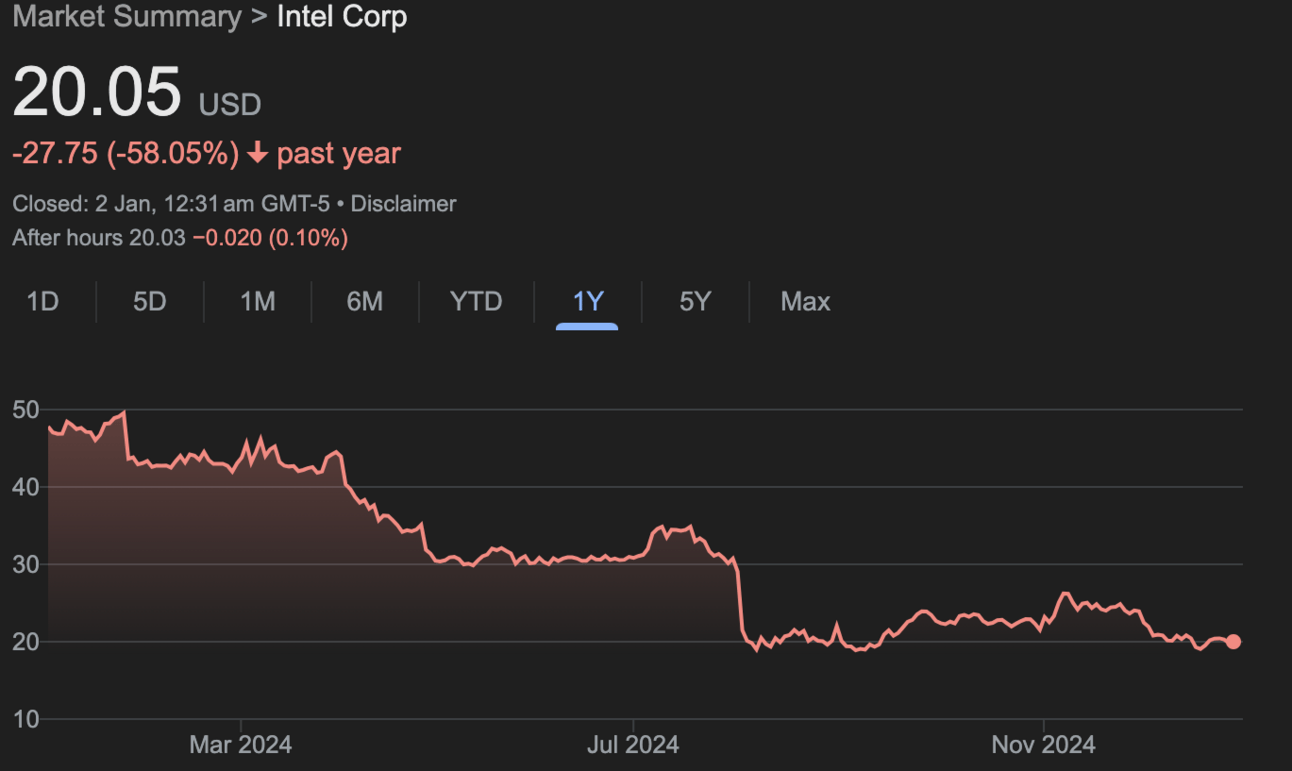Investing
Is Intel Stock Ready to Bounce Back in 2025? 🤔📉📈
.png)
Intel's stock has been in a downward spiral, but is there hope for a turnaround in 2025? After a massive 60% drop in 2024, many are questioning if the company has finally hit rock bottom or if it could fall even further. Let’s take a closer look at Intel’s recent struggles, leadership changes, and what’s next for the tech giant.
The Plunge of 2024: Intel vs. the Market 📉

Intel’s performance in 2024 was far from impressive. Shares of the chipmaker dropped by 60%, lagging behind the broader Nasdaq Composite, which rose by 29%. Even more telling, rival companies like Nvidia saw a 173% surge in stock price due to their leadership in artificial intelligence (AI) chip development. In contrast, Intel seems to have missed the boat on AI, sticking with its traditional chip business, while competitors like Nvidia and AMD focused on the rapidly growing AI market.
This sharp decline has left many investors wondering if Intel’s stock has more room to fall, or if it's already priced to reflect the worst-case scenario. According to Santosh Rao, head of research at Manhattan Venture Partners, most of the negative impact may already be baked into the stock, but the company will need time to catch up with competitors.
A New Era: Intel's Leadership Shakeup

Former Intel CEO Pat Gelsinger
Intel’s troubles didn’t stop at financial struggles. In December 2024, the company parted ways with CEO Pat Gelsinger after just over three years at the helm. Gelsinger’s departure comes amid mixed results from his aggressive efforts to turn the company around. While he secured funding for new chip plants and aimed to compete with Nvidia in AI, the company’s performance didn’t match expectations.
Intel’s board has since appointed CFO David Zinsner and former client computing head Michelle Johnston Holthaus as interim co-CEOs. However, the company is likely to hire a permanent CEO from outside the company, signaling that major changes are still ahead. Analysts believe that a new leader will have to stabilize the company’s finances, restore investor confidence, and decide whether to continue with Intel's costly chip foundry business.
Financial Woes: Losses and Write-Downs
Intel’s most recent earnings report revealed some troubling numbers. The company announced a $5.8 billion operating loss in its foundry business, with total sales of just $4.4 billion. On top of this, Intel took a $15.9 billion non-cash charge related to inventory write-downs and disappointing performance from its autonomous driving unit, Mobileye. In the fourth quarter, Intel’s sales dropped 6% year-over-year, and the company posted a net loss of $0.46 per share, far worse than the loss from the previous year.
These financial setbacks have led to further uncertainty about the company’s future, especially in the rapidly evolving world of AI and chip manufacturing.
What’s Next? A Long Road Ahead

So, what does the future hold for Intel?
Experts suggest that it could take a few years before the company gets back on track. Santosh Rao notes that Intel’s turnaround might not start showing results until 2026. For now, the company is in “work in progress” mode. While Intel has solid assets, its stock is currently valued at a 13% discount to its book value, indicating that investors are uncertain about its future prospects.
With its focus on traditional chips and a challenging road ahead, Intel will need strong leadership and a coherent strategy to catch up with rivals. As it stands, the stock remains under pressure, and analysts are cautious, with some advising to stay on the sidelines until the company can prove it’s heading in the right direction.
Conclusion: Can Intel Make a Comeback?
Intel’s stock in 2025 is still a big question mark. While it’s not clear whether the company can recover quickly, the road to a turnaround seems long and uncertain. If Intel’s new leadership can execute a solid strategy and regain investor trust, there could be hope on the horizon. However, with fierce competition from companies like Nvidia and AMD, Intel will need to innovate quickly to stay relevant in the fast-paced tech world. For now, investors and tech enthusiasts alike will be watching closely to see what happens next.





